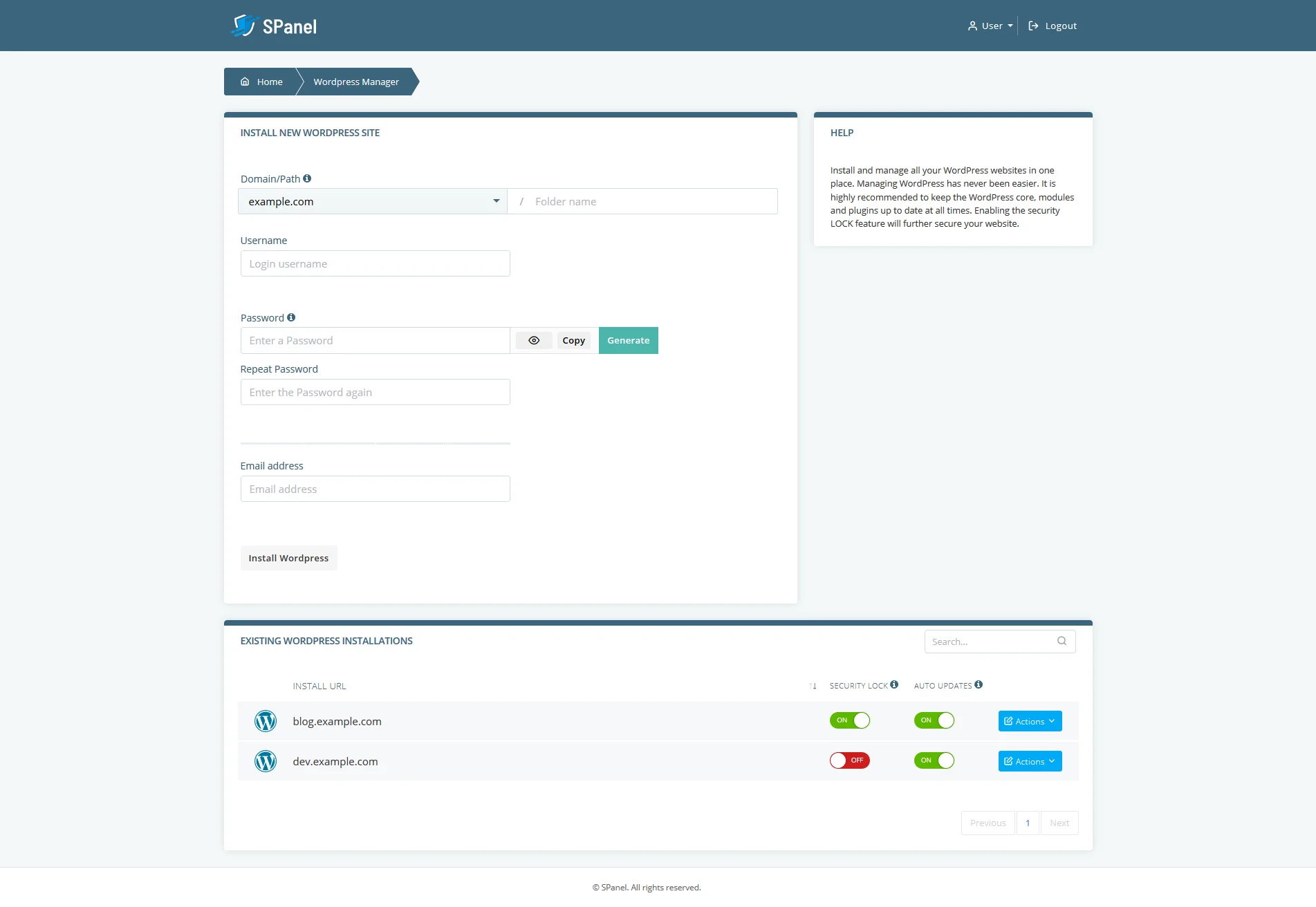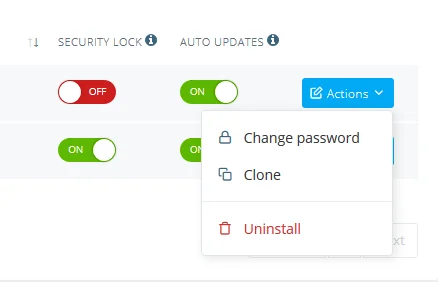WordPress is by far and away the most popular Content Management System (CMS) in the world. What started off as a simple blog platform now powers more than a third of the world’s websites, and it’s not difficult to see why.
Although it wasn’t the first CMS in the world, WordPress proved to be one of the most versatile and easy-to-use platforms of its kind, and, partly thanks to the fact that it’s free, people quickly adopted it. Despite the appearance of numerous point-and-click website builders, its popularity hasn’t dwindled, and it’s still considered the go-to solution for anyone trying to launch a new project. Unfortunately, its ease of use is also causing some problems.
Table of Contents
- What is SWordPress?
- Installing WordPress with SWordPress
- Configuring automatic updates and Security Lock
- Cloning, deleting, and changing passwords of WordPress installations with SWordPress
- Conclusion
Inexperienced website administrators overlook some important factors when working with WordPress, and even the seasoned developers don’t always bother with vital aspects of the platform’s configuration. As a result, many online businesses suffer from performance issues and cyberattacks. Manually installing and properly configuring WordPress can indeed be tricky. Fortunately, ScalaHosting customers can take advantage of our SWordPress Manager.
What is SWordPress?
SWordPress is a WordPress management tool that is integrated into SPanel and is available free of charge to anyone who picks one of ScalaHosting’s managed cloud VPS hosting solutions. It can install WordPress on your account, and it can also help you configure and secure it properly.
Managing content with WordPress might be an easy task, but getting the platform going in the first place normally requires a certain level of expertise. With SWordPress, however, you simply need to pick the location and login credentials, and your installation will be ready in seconds. SWordPress is far from just an installer, though.
Running up-to-date software is something far too many people have problems with, and this includes WordPress users. Thousands of WordPress websites run on versions of the platform that don’t perform as well as they should and are riddled with security holes. SWordPress gives you an easy way of enabling automatic updates and ensuring that your website runs smoothly and is secure.
This, along with a few other unique features, make SWordPress a brilliant tool for managing your entire WordPress installation. Let’s see how it works.
Installing WordPress with SWordPress
To install a WordPress site using SWordPress, you need to log into your account’s SPanel and go to WordPress Manager. At the bottom of the page, you’ll see a list of all existing WordPress installations, and above it is the form for creating a new one.
First, you need to choose where you’d like to install WordPress. From the drop-down menu, you can pick your main domain name, one of your addon domains, or a subdomain. If you want to install WordPress in a subfolder (e.g., domain.com/blog), you can specify this in the Folder name field.

After you’ve set the correct location, you need to pick the username and password for the WordPress administrator. The security of the entire website could be dependent on the complexity of the password, which is why SWordPress won’t let you continue with the installation unless the password is at least eight characters long and contains at least one letter, one digit, and one symbol.
To help you pick a truly unique password, SWordPress comes with an integrated password generator that you can use. Finally, you need to fill in the administrator’s email address. When you’re ready, click Install WordPress to initiate the process, and in a few seconds’ time, you should be able to see the new installation in the list at the bottom of the page.
Configuring automatic updates and Security Lock
Your WordPress installation is now ready, and you can log in and start managing your website. Before you do, however, you might want to take a look at a couple of toggle switches located next to your new WordPress installation.

One of them is labeled Auto Updates, and it’s switched on by default. Leaving it enabled is strongly recommended. This will ensure that not only WordPress itself, but also the plugins and themes you install later on will be updated without any action from your end. This way, all new features and performance improvements will be available on your WordPress installation, and you’ll also be sure that newly released security patches are installed in a timely manner.
The other toggle switch controls a feature called Security Lock. When it’s turned on, it limits access to your website’s files and directories. As a result, even if hackers manage to exploit a security vulnerability, they won’t be able to infect the website with malware. Meanwhile, you will be able to manage and upload new content without any difficulties.
Security Lock is a unique feature that takes your website’s security up a notch. The way it works, however, prevents you from installing new plugins and themes while it’s on. We realize that after you create a fresh WordPress installation, you will likely want to customize it, which is why Security Lock is turned off by default. We recommend enabling it as soon as you’re done setting up your website.
If Auto Updates and Security Lock are switched on, and there are new updates, SWordPress will automatically pause the Security Lock feature and will re-enable it as soon as the updates are applied.
Cloning, deleting, and changing the password of WordPress installations with SWordPress
Next to the Auto Updates and Security Lock toggles, you’ll see a drop-down menu that gives you yet more options for managing your WordPress installation.

If you feel that you need to change the password of the WordPress administrator, you can do it from here. You don’t need to know the old password, which ensures that even if you give another person administrative access to your website, you will still retain some control over it. Once again, you can use the built-in password generator to ensure that the new password is complex and unique.
The Actions drop-down menu also gives you the chance to Clone your WordPress installation. You can choose a path on your account (one of your domains, a subdomain, or a subfolder), and you can replicate the entire WordPress website, along with all the modifications you’ve made to it and all the content you’ve uploaded. This is especially useful if you’re developing a new version of your website in a hidden folder or a subdomain. Instead of arduous copy-pasting and re-configuring, once you’re ready with the new version, you can simply clone the entire WordPress installation on your live domain and deploy the new look in mere minutes.
If, on the other hand, you’re not happy with the way things are going, you can also delete your WordPress website with a couple of clicks. What you need to do is pick Uninstall from the Actions drop-down menu and then confirm that you really want to delete the website.
Conclusion
WordPress may be pretty intuitive to work with, but certain aspects of its installation and configuration might present a challenge without additional help. With the tools provided by SWordPress, you will be able to focus on your business while knowing that your website is properly configured and secured.
